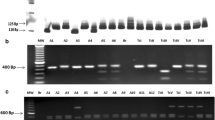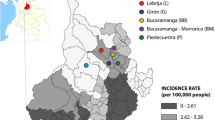Abstract
Two isolates of Trypanosoma cruzi were obtained from the patient Berenice, the first human case of Chagas’ disease (Chagas 1909), when she was 55 and 71 years old, respectively. The isolates were characterized on the basis of their epimastigote-trypomastigote differentiation in liquid media and of the electrophoretic pattern of EcoR1 digestion products of kinetoplast DNA (k-DNA) minicircles (schizodeme) and isoenzyme patterns (zymodeme). Clear differences were found between the isolates, suggesting the occurrence of a heterogeneous population of T. cruzi in the infection of this patient.
Similar content being viewed by others
Author information
Authors and Affiliations
Additional information
Received: 9 June 1995 / Accepted: 16 September 1995
Rights and permissions
About this article
Cite this article
de Lana, M., Chiari, C., Chiari, E. et al. Characterization of two isolates of Trypanosoma cruzi obtained from the patient Berenice, the first human case of Chagas’ disease described by Carlos Chagas in 1909. Parasitol Res 82, 257–260 (1996). https://doi.org/10.1007/s004360050106
Issue Date:
DOI: https://doi.org/10.1007/s004360050106




